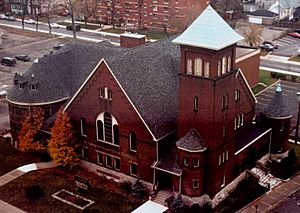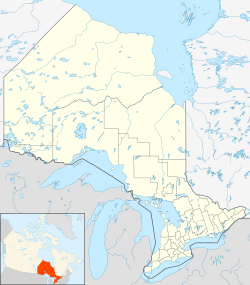St. Andrew's Presbyterian Church (Windsor, Ontario) facts for kids
Quick facts for kids RCCG Throne of Grace Windsor |
|
|---|---|

RCCG Throne of Grace, Windsor Former: St. Andrew's Presbyterian Church, Windsor
|
|
| 42°18′56″N 83°02′26″W / 42.3156°N 83.0406°W | |
| Location | Windsor, Ontario, Canada |
| Denomination | Redeemed Christian Church of God |
| Website | http://www.rccgwindsor.com |
| History | |
| Founded | 1857 |
| Architecture | |
| Architect(s) | Spier & Rohns |
| Administration | |
| Presbytery | Essex-Kent |
St. Andrew's Presbyterian Church was a well-known church in downtown Windsor, Ontario, Canada. It was part of the Presbyterian Church in Canada. This church started way back in 1857. For a while, it was the biggest Presbyterian church in Canada based on how many members it had. Today, the building is home to the RCCG Throne of Grace Windsor church.
Contents
The Church's Early Days
The first group of people who formed St. Andrew's Presbyterian Church came together in 1857. Twenty-nine Presbyterians asked for their own church. They wanted to separate from a church in Detroit. Permission was given on July 1, 1857.
First Meetings and Leaders
St. Andrew's chose its first leaders, called the Session, on July 12. They had their first meeting in early August with 32 founding members. Alexander Bartlet was a very important early leader. He was the Session Clerk until he passed away in 1910. He also led the Sunday school for many years.
Where They Met
In the beginning, the church did not have its own building. Services were held in a room above a store owned by John McCrae. This same room was also used by the local government. Sometimes, meetings were held at the Old Ward School. It was hard to find a full-time minister because the group was small. Often, ministers from Detroit or missionaries would come to lead services.
Building the First Churches
In July 1861, two Presbyterian groups joined together. They became the Canada Presbyterian Church. The first minister to serve in Windsor was Rev. William Bennet from Ireland. He started in October 1861.
The first building for St. Andrew's was built in 1865. It was located at Victoria Avenue and Chatham Street. In May 1866, Rev. Alexander Ferrier Kemp became the second minister. He later became a professor at Olivet College in Olivet, Michigan.
Rev. John Gray followed Dr. Kemp in 1870. During his time, the church built a new brick building in 1883. This new church was at Victoria and Park Street. Sadly, this building burned down completely on March 16, 1895.
The Current Church Building
The fire in 1895 led to the building of the church you see today. The first service in this new building was held on June 14, 1896. The church was first designed to hold 800 people. Balconies were added in 1903, which allowed 400 more people to sit.
Important Ministers and Growth
Rev. James C. Tolmie served the church from 1893 to 1915. He also became a politician, serving as a Member of Provincial Parliament for Windsor.
Rev. Dr. Hugh M. Paulin arrived in late 1915. He served the church for over 35 years until his death in October 1952. In 1925, the church members voted on whether to join the United Church of Canada. Only 18 people voted to join, while 607 voted against it. St. Andrew's remained a Presbyterian church. By the time Dr. Paulin passed away, the church had more than 2,000 members. It was the largest Presbyterian church in Canada for many years.
Later ministers included Rev. Dr. William Lawson (1953-1981) and Dr. Robert Fourney (1982-1996). Rev. Dr. Jeff Loach served from 1997 to 2004.
Building Updates and Special Events
In 1983, an addition was built onto the church. This included the Meeting Place and the Herman-Clark Hall. The offices and Sunday School rooms were also updated.
The church hosted a big event in June 1980. It was the General Assembly of the Presbyterian Church in Canada. The opening service was held at St. Andrew's. The rest of the event took place at the University of Windsor. The General Assembly returned to Windsor in June 1997.
A New Chapter for the Building
The congregation celebrated its 150th anniversary in 2007. Rev. Ronald Sharpe became the ninth Senior Minister that year.
The building also hosts a Chinese-speaking church. This group, called the Windsor Chinese Presbyterian Church, holds services on Sunday afternoons.
In May 2016, the St. Andrew's congregation decided to stop its operations. They voted to sell the building due to money concerns. The building was then bought by The Redeemed Christian Church of God. Today, this church, RCCG Throne of Grace, continues to use the historic location. They welcome everyone and run important community programs. These include soup kitchens and a food bank for people who need help.


